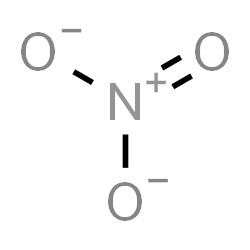
Which of the following is true for nitrate anion.
A.The formal charge on \[N\] is zero
B.The bond order of \[NO\] bond is $\dfrac{4}{3}$
C.The average formal charge on oxygen is \[\dfrac{1}{3}\]
D.There are \[2-\pi \] bonds in the ion
Answer
561.9k+ views
Hint: To answer this question, you should recall the concept of formal charge and bond order. It’s a theoretical charge over an individual atom of an ion as the real charge over a polyatomic molecule or ion is distributed on an ion as a whole and not over a single atom.
The formula used: \[{\text{FC}} = {\text{V}} - {\text{N}} - \dfrac{{\text{B}}}{{\text{2}}}\]
where $V$ is the no. of valence electron \[N\] is the no. of non-bonding electrons and \[B\] is the no. of electrons in the covalent bond
Complete Step by step solution:
The bond order shows the number of chemical bonds present between a pair of atoms. For instance, the bond order of diatomic nitrogen \[N \equiv N\] is 3 and bond order between the carbon atoms in \[H - H \equiv C - H\] is also three. The bond order describes the stability of the bond. The molecular orbital provides an easy understanding of the concept of the bond order of a chemical bond. It quantifies the degree of covalent bonds between the atoms. The formal charge of nitrogen can be calculated using: \[{\text{FC}} = {\text{V}} - {\text{N}} - \dfrac{{\text{B}}}{{\text{2}}}\]
(V = no. of valence electron N = No. of nonbonding electrons B = No. of electrons in covalent bond)
\[{\text{FC of N in N}}{{\text{O}}_{\text{3}}}^ - = 0\]
\[{\text{FC of O in N}}{{\text{O}}_{\text{3}}}^ - = - \dfrac{1}{3}\]
The Lewis structure of nitrate ion can be drawn as:

We can see that the total number of bonds = 4.
The number of bond groups between individual atoms = 3 and bond order \[ = \dfrac{{4}}{3} = 1.33\]. There is one pi bond.
Therefore, we can conclude that the correct answer to this question is option D.
Note: In most of the compounds, the oxidation number of oxygen is $ - 2$ . There are two exceptions here.
Peroxides: Each oxygen atom exhibits an oxidation number of $ - 1$ . Example, \[N{a_2}{O_2}\]
Superoxide- Every oxygen atom is allocated an oxidation number of \[ - \dfrac{{{\text{ }}1}}{2}\] . Example, \[K{O_2}\]
Oxygen is bonded to fluorine- Example, dioxygen difluoride where the oxygen atom is allocated an oxidation number of $ + 1$ .
The formula used: \[{\text{FC}} = {\text{V}} - {\text{N}} - \dfrac{{\text{B}}}{{\text{2}}}\]
where $V$ is the no. of valence electron \[N\] is the no. of non-bonding electrons and \[B\] is the no. of electrons in the covalent bond
Complete Step by step solution:
The bond order shows the number of chemical bonds present between a pair of atoms. For instance, the bond order of diatomic nitrogen \[N \equiv N\] is 3 and bond order between the carbon atoms in \[H - H \equiv C - H\] is also three. The bond order describes the stability of the bond. The molecular orbital provides an easy understanding of the concept of the bond order of a chemical bond. It quantifies the degree of covalent bonds between the atoms. The formal charge of nitrogen can be calculated using: \[{\text{FC}} = {\text{V}} - {\text{N}} - \dfrac{{\text{B}}}{{\text{2}}}\]
(V = no. of valence electron N = No. of nonbonding electrons B = No. of electrons in covalent bond)
\[{\text{FC of N in N}}{{\text{O}}_{\text{3}}}^ - = 0\]
\[{\text{FC of O in N}}{{\text{O}}_{\text{3}}}^ - = - \dfrac{1}{3}\]
The Lewis structure of nitrate ion can be drawn as:

We can see that the total number of bonds = 4.
The number of bond groups between individual atoms = 3 and bond order \[ = \dfrac{{4}}{3} = 1.33\]. There is one pi bond.
Therefore, we can conclude that the correct answer to this question is option D.
Note: In most of the compounds, the oxidation number of oxygen is $ - 2$ . There are two exceptions here.
Peroxides: Each oxygen atom exhibits an oxidation number of $ - 1$ . Example, \[N{a_2}{O_2}\]
Superoxide- Every oxygen atom is allocated an oxidation number of \[ - \dfrac{{{\text{ }}1}}{2}\] . Example, \[K{O_2}\]
Oxygen is bonded to fluorine- Example, dioxygen difluoride where the oxygen atom is allocated an oxidation number of $ + 1$ .
Recently Updated Pages
Why are manures considered better than fertilizers class 11 biology CBSE

Find the coordinates of the midpoint of the line segment class 11 maths CBSE

Distinguish between static friction limiting friction class 11 physics CBSE

The Chairman of the constituent Assembly was A Jawaharlal class 11 social science CBSE

The first National Commission on Labour NCL submitted class 11 social science CBSE

Number of all subshell of n + l 7 is A 4 B 5 C 6 D class 11 chemistry CBSE

Trending doubts
Differentiate between an exothermic and an endothermic class 11 chemistry CBSE

10 examples of friction in our daily life

One Metric ton is equal to kg A 10000 B 1000 C 100 class 11 physics CBSE

Difference Between Prokaryotic Cells and Eukaryotic Cells

1 Quintal is equal to a 110 kg b 10 kg c 100kg d 1000 class 11 physics CBSE

State the laws of reflection of light




